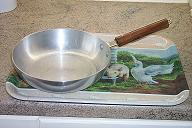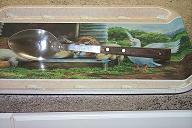What pan should be used to cook a curry?
If you see a curry cooked in an Indian restaurant you will likely observe that the pan used will be about 10 inches (26 cm) in diameter, made of aluminium and have reasonably steep sides (about 2½ inches or 6 cm) with a gradually curving transition from the pan base to pan side. These can be purchased in many Indian stores for as little as £6.00 and a picture of one such pan is shown here...The ideal pan

back to top
What spoon should be used to cook a curry?
The chef's spoon
back to top
How to experiment with 'Base Sauce' ingredients
The experimentation process to be described requires a dedication to curry making that most people do not possess but if you are a dedicated curry lover and want to make curries at home like you get in a high street restaurant then this may be just what you need.'Base sauce' is used in most High Street Indian restaurants and take-away's (along with a good quantity of oil) to provide the cooking medium for most, if not all, of the curries on their menu. Each restaurant likely has their own way of making this 'base sauce' which means that most of the curries on their menus have a distinctive background flavour. This helps to distinguish one 'curry house' from another but causes many of the curries on offer to be very similar in flavour. Punters will consequently have their own favourite BIR (British Indian Restaurant) that they regularly patronise.
Adding to this is the national and regional origin of the restaurant chef, each with their own individual cooking style and commonly used spices or 'spice mix'.
Cooking styles and spice usage are the subject for another discussion but here we will concentrate on the 'base sauce' and how to experiment with a variety of ingredients.
An Indian restaurant will make 'base sauce' in large quantities sufficient for the expected day's usage, topping it up or making a fresh batch every day before opening time. Re-creating the 'base sauce' in a domestic kitchen will require a much smaller amount to be made, typically greater than 1 litre and up to 3 litres. The larger quantity will require a stock pot of about 5 litres capacity in order to prevent the contents from boiling over. Experimenting with the larger quantities could prove time consuming and quite wasteful if the result is not as desired so a simpler and more convenient method is now described...
Step 1
The first step is to make a full batch quantity, say 2400 ml, of a lightly spiced base sauce. The C46 base sauce is a convenient starting point. A single 300 ml portion will be used as the basis for the experiment.
If the full quantity of base sauce is, for example, 2400 ml, then the 300 ml quantity is one eighth of the total quantity. Hence any additions made to the 300 ml quantity used in the experiment will need to be multiplied by eight when being applied to a full batch quantity.
Step 2
Ingredient variations could be herbs, spices, vegetables or even other ingredients such as coconut and vegetable fat. The ingredients used could be added or removed or varied in quantity. (Clearly, ingredients already part of the sample of base sauce being used cannot be removed, so these will need to be omitted when making the full batch.) The vegetables used could include red/green peppers, carrot, celery, red/green/white cabbage, fennel, ginger, garlic, red/white onions, red/white/sweet potato etc... the list goes on and on. It can readily be seen that a wide range of base sauce variations can be made from this limited list of ingredients.
Step 3
Imagine we wish to try the addition of some cabbage to give a 'savoury' taste. How much should be used? If you have access to other base sauce recipes that contain cabbage you could use this as a starting point, but if not try a quantity such as 25 - 30 gm. If adopted as a final base sauce ingredient this would equate to between (8 x 25) to (8 x 30) gm or 200 to 240 gm.
For our experiment choose 25 gm of green (savoy) cabbage and finely chop. Then add it to the 300 ml of base sauce and bring to a boil. Then simmer, covered, for say 15 minutes (it can be checked for taste at this point). Finally, blend this until smooth and, if needed, add sufficient hot water to bring the quantity back to 300 ml. This can then be tasted again and the process repeated if you feel the quantity of cabbage was insufficient. When happy with the result it can be used to cook your favourite curry for a final evaluation. If you decide that this flavour variation is to your taste, then add 8 times the quantity when making a full batch of base sauce.
Remember that some additional ingredients will cause the sauce to thicken, so the final result may require thinning. If the sauce needs significant thinning then the quantity of base sauce ingredients per-portion will be reduced, thereby changing the flavour somewhat. This is not an exact science and may require some experimentation before the desired result is achieved but that's what it's all about.
The flavour of a full batch may not be exactly the same as the 300 ml portion due to the fact that ingredients sometimes do not scale linearly (tech speak) but it will provide a good basis for any final adjustments you may wish to make.
The same principle can be used with other ingredients.
back to top
How to cook for several people?
Most 'normal' Indian take-away's and restaurants make single portions and do not usually cook multiple portions at one time. One reason for this is that spices and ingredients do not scale linearly and so making several portions in a single pan would cause a flavour imbalance. It is much better to make single portions putting them in covered foil trays in a warm oven until all meals have been cooked and the rice is ready. A reasonable oven temperature for this would be around 150°C.back to top
How much chicken per portion?
This rather depends on individual appetite but something around 100 - 110 gm of cooked chicken is about right. It must be noted that the weight of the chicken is likely to reduce during cooking, especially if frozen breasts have been used. Cooked 'frozen' chicken (defrosted before cooking) will be about 86% of the uncooked weight, so a single portion of uncooked chicken should weigh between 116 - 128 gm. Ok, if you have a really good appetite use 150 gm of uncooked chicken.back to top
How much rice per portion?
For long grained rice, between 85 - 100 gm is usually sufficient for one portion.back to top
How to cook perfect boiled rice
There are many opinions on this but the method I learnt from Delia Smith always works with perfect results. This method uses enough water so that a significant amount still remains after the rice is cooked.Method
(1) Bring the water (salted) to a boil and add the rice.
(2) Bring back to a boil and stir well, scraping the bottom of the saucepan to release any grains stuck to the bottom of the pan.
(3) Cover the saucepan and reduce the heat to a minimum and cook undisturbed for between 12 - 15 mins (see instructions on packet).
(4) Remove from the heat, stir again, scraping the pan bottom to release any stuck grains and strain.
It is worth noting that if too much rice is cooked in one pan, the weight of the rice will compress the lower grains and the result will be a sticky mess.
If this technique is followed, it will perfect every time.
back to top
What oil should be used?
Take-away's and high street Indian restaurants will usually use the cheapest ingredients they can find and oil is no exception. Normally a vegetable oil will be used, but at home any oil will be ok. In these days of health consciousness some people will only use olive oil and I have used this when making the base sauce and individual curries. It is better not to use a very strongly flavoured oil but a mild olive oil will probably not be noticed in the final dish at all. Indeed some restaurants specifically mention that they do use olive oil, evidently appealing to the more health conscious amongst us. So use your own preference and if you enjoy the result, stick with it.back to top
